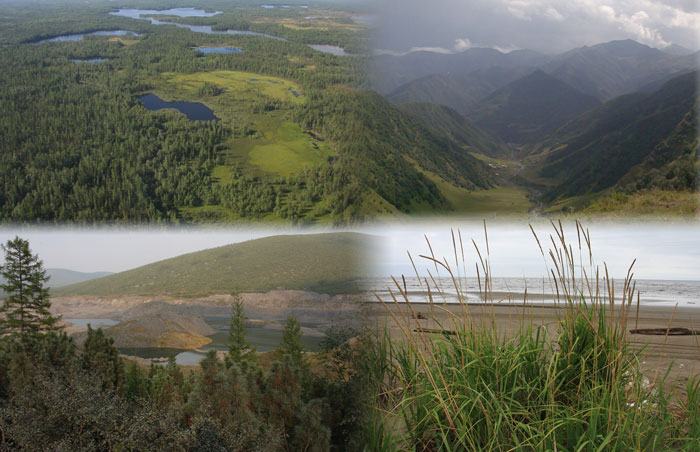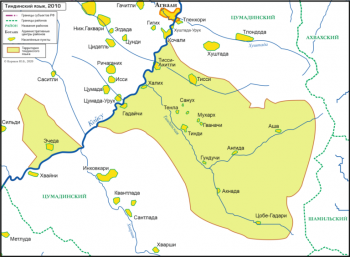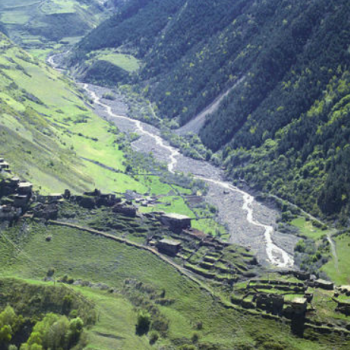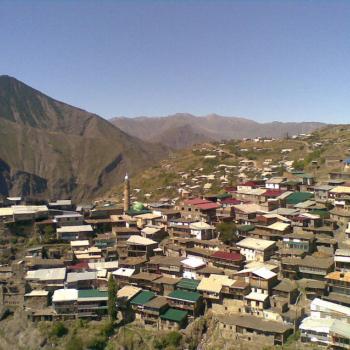Brief Information
Tindi is spoken in several villages of the Tsumada district of Dagestan, as well as in the resettlement villages in the lowland area.
In the 1939 census, Tindi people have officially been registered as Avars. Therefore, it is difficult to determine the exact number of the Tindi speakers in the context of intensive migration of the population. It is approximately more than twenty thousand people. According to the 2010 census, the number of the Tindi speakers is about 9300 thousand people.
Tindi does not have a strong dialect differentiation. The differences between the dialects mainly concern the phonetic differences. There are two dialect groups: Tindi-Echeda and Angida-Aknada. Tindi was also knows as Tindal and Ideri. The Tindi people do not have a general ethnic name. They call themselves, respectively, by the names of their villages. Close neighbors, Chamalals, Bagvalals and Avars, call them by the name of the largest village – Tindi.
The traditional occupations of the Tindi people are agriculture, cattle breeding, beekeeping, and hunting. All Tindi people are Sunni Muslims.
Genealogy
Tindi belongs to the Andic group of the Nakh-Daghestanian language family.
Distribution
Tindi-Echeda dialect
Tindi of Tsumada district (Dagestan, Russia)
Echeda of Tsumada district (Dagestan, Russia)
Tissi of Tsumada district (Dagestan, Russia)
Tissi-Akhitli of Tsumada district (Dagestan, Russia)
Shava of Tsumada district (Dagestan, Russia)
Asha of Tsumada district (Dagestan, Russia)
Gadaychi of Tsumada district (Dagestan, Russia)
Angida-Aknada dialect
Angida village of Tsumada district (Dagestan, Russia)
Aknada village of Tsumada district (Dagestan, Russia)
Aknada of Kizilyurtovsky district (Dagestan, Russia)
Angida of Kizilyurtovsky district (Dagestan, Russia)
Tindi-Echeda and Angida-Aknada dialects
Pyatiletka of Khasavyurtovsky distrisct (Dagestan, Russia)
Aksay village of Khasavyurtovsky distrisct (Dagestan, Russia)
Chontaul village of Khasavyurtovsky distrisct (Dagestan, Russia)
Dialects and their distribution
Language contacts and multilingualism
Currently, the Tindi people speak Avar and Russian.
Language functioning
- Legal status
- Writing system
- Language standardization
- Domains of language usage
Tindi has no official status.
Tindi is an unwritten language. Tindi does not have an officially established writing system.
Tindi has no established literary standard. The native speakers of different dialects speak their own dialects with each other.
Family / everyday communication
Family / everyday communication
Tindi is used in the family and domestic spheres as well as in the informal communication between the inhabitants of Tindi-speaking villages.
Education
Education
In educational domain, Tindi is not the subject of study. In rural areas, Tindi schoolchildren learn Avar as their native language subject. In preschool and primary school, Tindi is an informal language of instruction and education. There are no textbooks or teaching aids in Tindi.
Mass media
Mass media
Tindi is not used in the media. In this domain, Russian and Avar languages are used.
Culture
Culture
There are no Tindi theater and cinema. Avar and Russian are used in these domains.
Science
Science
There are no scientific works published in Tindi. Russian is used in this domain.
Folklore
Folklore
There are no folkloric texts in Tindi.
Literature
Literature
There are no literary works created in Tindi.
Religion
Religion
Some of the rituals and chants are performed in Tindi; additionally, Avar and Arabic are used in religious domain.
Legislation
Legislation
Russian is used as the language of legal proceedings in the Republic of Dagestan.
Administrative activities
Administrative activities
Tindi is not the language of paperwork management and business correspondence. However, in its oral form it is often used in the administrations of Tindi-speaking villages
Legal proceedings
Legal proceedings
Russian is used as the language of legal proceedings in the Republic of Dagestan.
Industry
Industry
There is no industry in the Tindi region.
Agriculture
Agriculture
Tindi is used in oral communication.
Trade and service
Trade and service
Tindi is used in services and trade in the Tindi-speakig villages.
Transport
Tindi is used in communication in local transportation.
Internet
Internet
There are no official websites, chats and groups in social networks on the Internet in Tindi. Russian is used in this domain.
Dynamics of language usage
Tindi remains the primary means of communication among the Tindi people, despite the fact that most Tindi identity themselves as Avar. At the same time, the knowledge of Avar among the Tindi people is decreasing every year due to the spread of mass media (television, radio, press, etc.) in Russian. Nowadays, the knowledge of Russian is almost absolute.
The knowledge of Tindi is considerably high in compact living areas. In general, the transmission of Tindi to the children is maintained. The level of proficiency of Tindi amongst the youngest generation living in urban areas is decreasing.
Language structure
Phonetics
Tindi has 20 vowels and 46 consonants.
Phonetics
Tindi has 20 vowels and 46 consonants.
Tindi has a developed system of vocalism. It contains simple, long, and nasalized vowels. Simple vowels are a, e, i, o, u. Of the long vowels (ā, ē, ī, ō, ū) ō and ī are rare. The length of the vowels is the result of combinatorial changes in sounds, which consist in the merger of two simple vowels after the loss of a consonant between them: ɬēr < ɬеʔer . The vowel length also has a form-distinguishing function. Nasalized vowels can be both simple (an, in, en, on, un) and long (ān, īn, ēn ēn, ōn, ūn) vowels. Nasalized vowels are less common in the Aknada and Angida dialects.
| simple | nasalized | |||||||
| short | long | short | long | |||||
| i | u | ī | ū | i n | u n | ī n | ūn | |
| e | o | ē | ō | e n | o n | ēn | ōn | |
| a | ā | an | ān | |||||
A characteristic feature of the Tindi consonant system is the presence of 5 palatal phonemes (gj, kj, k’j, łj и xj) , for example, gj (gjali «theft»), kj (kjeba «calf skin»), k’j (k’jaru «knot») . There is no contrast in intensity in the ejective consonants, the affricate is represented only in a few cases. Labialization occurs in all consonants except labial ones, for example, hek'wa ‘man’, q'warab 'close', žwalak'a 'worm'.
| t’ | k’ | k’j | q’ | ʔ | ||||
| p | t | k - kk | kj – kkj | q | ||||
| b | d | g | gj | |||||
| v | z | ž | łj | ʁ | ʕ | |||
| s-ss | š-šš | ł - łł | x | xj | χ – χχ | ħ | h | |
| c’ | č’ | ƛ’ | ||||||
| c – cc | č-čč | ƛ | ||||||
| m | n | j, r |
The main phonetic process in the Tindi language is assimilation.
The most typical syllabic structures are CV, CVC, and VC.
Morphology
Tindi is agglutinative with fusional and analytic elements.
Morphology
Tindi is classified as an agglutinative language (with rich nominal and verbal morphology), with some fusional elements in word formation and analytic elements in structure of some verb forms.
Syntax
Tindi is classified as the language with ergative–absolutive alignment. The basic word order is SOV, but in general the word order is free.
Syntax
Within noun phrases, most modifiers precede the head noun.
Vocabulary
The Avar, Arabic, Persian, Russian and Turkic languages are the main sources of word borrowing.
Vocabulary
There are two major lexicon stratum, inherent and borrowed. The inherent vocabulary forms the major body of the lexicon. Chronologically, the earlier borrowings are from Avar and Arabic, and the later ones are from Persian, Turkic, and Russian. The majority of borrowings comes from Arabic and Russian, the lowest number — from Avar, Farsi and Turkic.
Исследование языка
Important studies on Tindi are in Gudava [1953], [1954], and 1969. The first Tindi dictionary is by Magomedova (2003).
Language experts

Gilles Authier
Gilles Authier is actively studying the morphology and syntax of Tindi.
Core references
Grammatical descriptions: grammars, sketches
Authier, G. (2020). Tindi (Y. Koryakov & T. Maisak, Eds.). Berlin/New York: De Gruyter Mouton.
Gudava, T. 1953. Foneticheskij obzor tindinskogo jazyka. Tbilisi.
Gudava, T. 1954. K istorii grammaticheskix klassov v tindinskom jazyke. Tbilisi.
Magomedbekova, Z. M. (1998). Tindinskij jazyk [Tindi]. In Mixail E. Alekseev, G. A. Klimov, S. A. Starostin, & J. G. Testelec (Eds.), Jazyki mira. Kavkazskie jazyki [Languages of the world. Caucasian languages] (pp. 25–32). Moscow: Academia.
Magomedova, P. T. (2012). Tindinskij jazyk [Tindi]. Makhachkala: IJaLI.
Dictionaries
Magomedova, P. T. (2003). Tindinsko-russkij slovarʹ [Tindi-Russian dictionary]. Makhachkala: IJaLI.
Работы по этнологии
Magomedxanov M. M., Musaeva M. K. 2009. Tindaly (ethnographical sketch XIX-XX cc.)
Resources
Corpora and text collections
There is no publicly available electronic corpus of Tindi.
Other electronic resources
The Intercontinental Dictionary Series (IDS), which is a database with lexical material, contains wordlists of Tindi —1584 entries.
Data for this page kindly provided by
Zaira Madzhidovna Khalilova (Institute of Linguistics of the Russian Academy of Sciences, Moscow).
References used:
Authier, G. (2020). Tindi (Y. Koryakov & T. Maisak, Eds.). Berlin/New York: De Gruyter Mouton.
Magomedbekova, Z. M. (1998). Tindinskij jazyk [Tindi]. In Mixail E. Alekseev, G. A. Klimov, S. A. Starostin, & J. G. Testelec (Eds.), Jazyki mira. Kavkazskie jazyki [Languages of the world. Caucasian languages] (pp. 25–32). Moscow: Academia.
Magomedova, P. T. (2003). Tindinsko-russkij slovarʹ [Tindi-Russian dictionary]. Makhachkala: IJaLI.
Magomedova, P. T. (2012). Tindinskij jazyk [Tindi]. Makhachkala: IJaLI.






